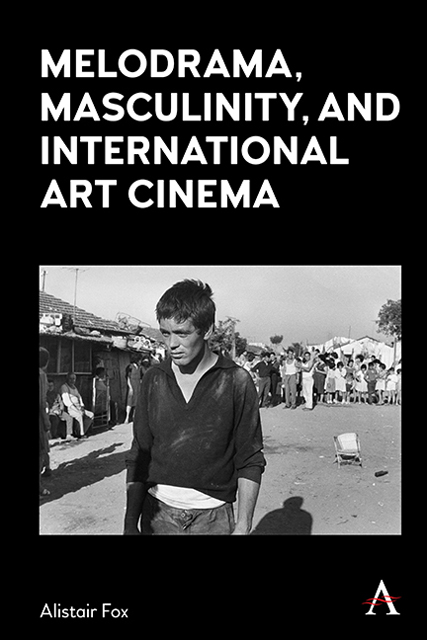Book contents
- Frontmatter
- Dedication
- Contents
- List of Figures
- Preface
- Acknowledgments
- Introduction
- Chapter 1 Italian Neorealism and the Emergence of the Male Melodrama: Vittorio De Sica’s Bicycle Thieves (1948) and Umberto D. (1952)
- Chapter 2 The Migration of Male Melodrama into Non-Western Cultures: Satyajit Ray’s The Apu Trilogy (1955–59) and “Fourth Cinema”
- Chapter 3 Hollywood Melodrama as a Vehicle for Self-Projection: Vincente Minnelli’s Tea and Sympathy (1956) and Home from the Hill (1960)
- Chapter 4 The Political Turns Personal: Neo-Neorealism and Pier Paolo Pasolini’s Accattone (1961)
- Chapter 5 Personal Cinema as Psychodrama: Ingmar Bergman’s Wild Strawberries (1957), Winter Light (1963) and Hour of the Wolf (1968)
- Chapter 6 François Truffaut and the Tyranny of Romantic Obsession: The Soft Skin (1964), Mississippi Mermaid (1969) and The Woman Next Door (1981)
- Chapter 7 Figuring an Authorial Fantasmatic: Jacques Demy’s The Umbrellas of Cherbourg (1964), A Room In Town (1982) and Parking (1985)
- Chapter 8 Rainer Werner Fassbinder and the Emergence of Queer Cinema: The Merchant of Four Seasons (1972), Fox and His Friends (1975) and In a Year with 13 Moons (1978)
- Chapter 9 Visual Aestheticism and the Queer Prestige Melodrama: Call Me by Your Name (2017) and Luca Guadagnino’s Desire Trilogy
- Conclusion
- List of Films Cited
- Select Bibliography
- Index
- Frontmatter
- Dedication
- Contents
- List of Figures
- Preface
- Acknowledgments
- Introduction
- Chapter 1 Italian Neorealism and the Emergence of the Male Melodrama: Vittorio De Sica’s Bicycle Thieves (1948) and Umberto D. (1952)
- Chapter 2 The Migration of Male Melodrama into Non-Western Cultures: Satyajit Ray’s The Apu Trilogy (1955–59) and “Fourth Cinema”
- Chapter 3 Hollywood Melodrama as a Vehicle for Self-Projection: Vincente Minnelli’s Tea and Sympathy (1956) and Home from the Hill (1960)
- Chapter 4 The Political Turns Personal: Neo-Neorealism and Pier Paolo Pasolini’s Accattone (1961)
- Chapter 5 Personal Cinema as Psychodrama: Ingmar Bergman’s Wild Strawberries (1957), Winter Light (1963) and Hour of the Wolf (1968)
- Chapter 6 François Truffaut and the Tyranny of Romantic Obsession: The Soft Skin (1964), Mississippi Mermaid (1969) and The Woman Next Door (1981)
- Chapter 7 Figuring an Authorial Fantasmatic: Jacques Demy’s The Umbrellas of Cherbourg (1964), A Room In Town (1982) and Parking (1985)
- Chapter 8 Rainer Werner Fassbinder and the Emergence of Queer Cinema: The Merchant of Four Seasons (1972), Fox and His Friends (1975) and In a Year with 13 Moons (1978)
- Chapter 9 Visual Aestheticism and the Queer Prestige Melodrama: Call Me by Your Name (2017) and Luca Guadagnino’s Desire Trilogy
- Conclusion
- List of Films Cited
- Select Bibliography
- Index
Summary
In cinema studies, masculinity has tended, with a few exceptions, to be presented as a monolithic category that serves the interests of a hegemonic, normative patriarchy. This book will argue that the evolution of the art film, notably in the form of personal cinema, through its exploitation of the melodramatic mode, tells a different story, offering a vision of masculinity that is sexually fluid, fragmented, unstable, and often incapacitated to the point of paralysis—a masculinity that is undermined not only from within, but also by external circumstances. Hollywood, in the form of “male weepies,” offered preliminary insights into this destabilized masculinity, but it is with the flowering of post–World War II art film and its subsequent movement into the Indie waves of the late twentieth century and the early twenty-first century that cinema more profoundly realizes its potential to serve as a vehicle for the exploration of men’s interior lives, developing what might be termed the male melodrama, the correlative of the woman’s film.
The present volume offers a series of case studies that reassess the role of melodrama in a number of touchstone films in the art-cinema tradition that explore the subjective experience of a male protagonist, announcing the emergence of a genre that has progressively developed into a major form in contemporary cinema. Although these films, made by such notable auteurs as Vittorio De Sica, Pier Paolo Pasolini, Ingmar Bergman, François Truffaut, Jacques Demy, Satyajit Ray and Rainer Werner Fassbinder, have frequently been discussed as outstanding examples of art films, to date they have not been examined, with a few isolated exceptions, in terms of their representation of gender and subjectivity, which has left a lacuna in accounts of screened masculinities.
Even though masculine experience generally has been one of the major preoccupations of filmmakers, a cursory glance at popular cinema genres will show that for the most part screened masculinities have depicted men as heroic actors in roles traditionally assigned to them by normative codes of masculinity. Hence, in action films, westerns, crime thrillers and war films there has been an emphasis on ritualized conflicts (such as gunfights, gangland shootouts, gladiatorial combats and so forth), on the male body as a vehicle for display (of musculature, beauty, physical feats and toughness), and often on homosocial bonding between males, as in the buddy film.
- Type
- Chapter
- Information
- Melodrama, Masculinity and International Art Cinema , pp. 1 - 14Publisher: Anthem PressPrint publication year: 2022

